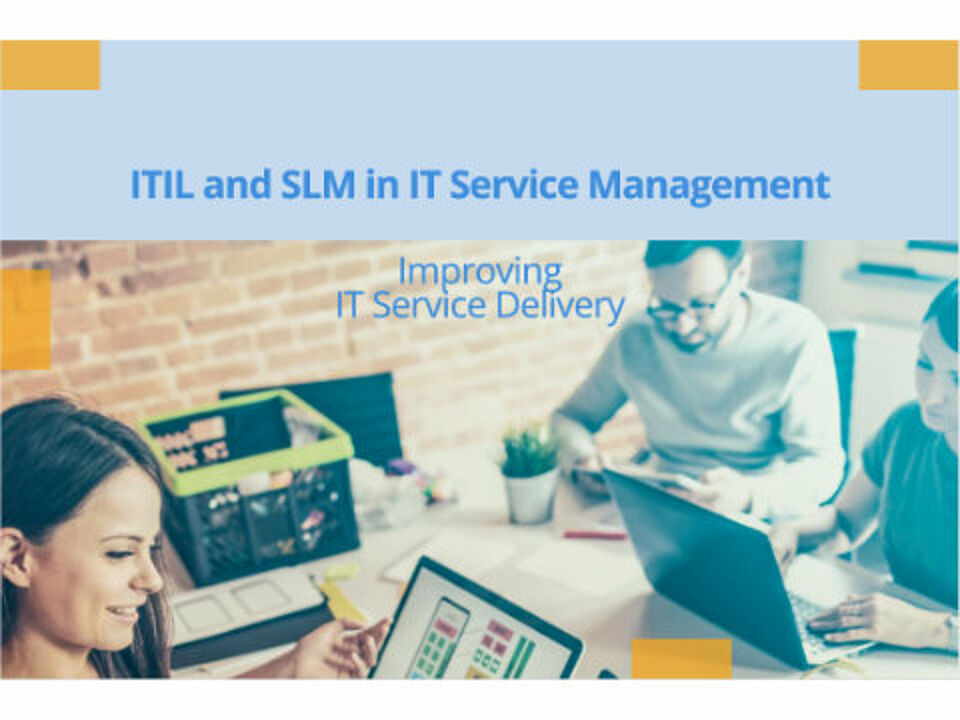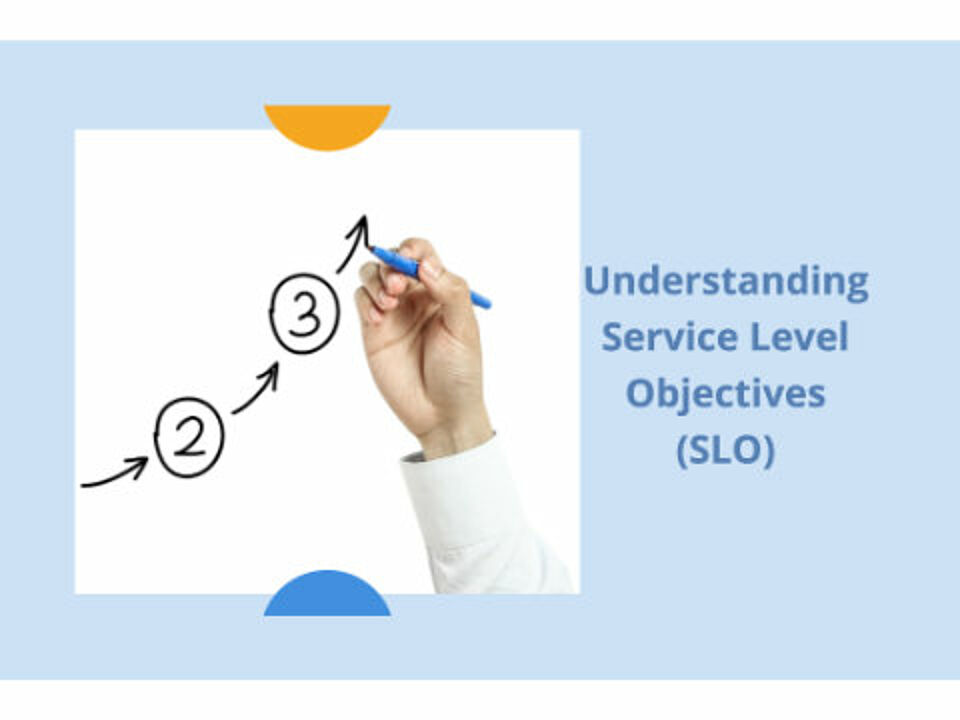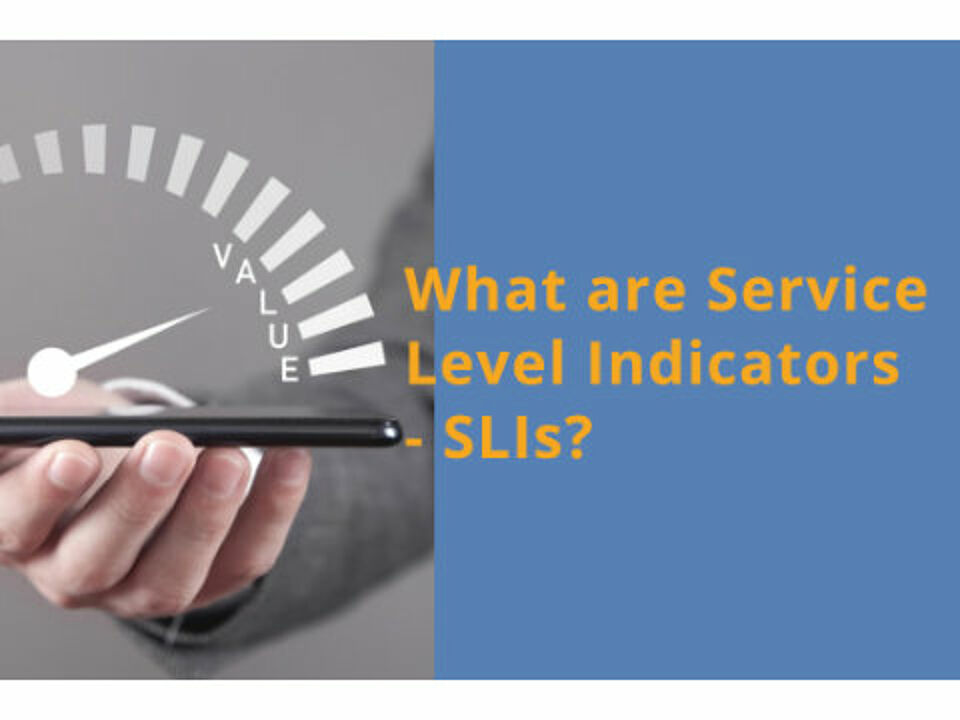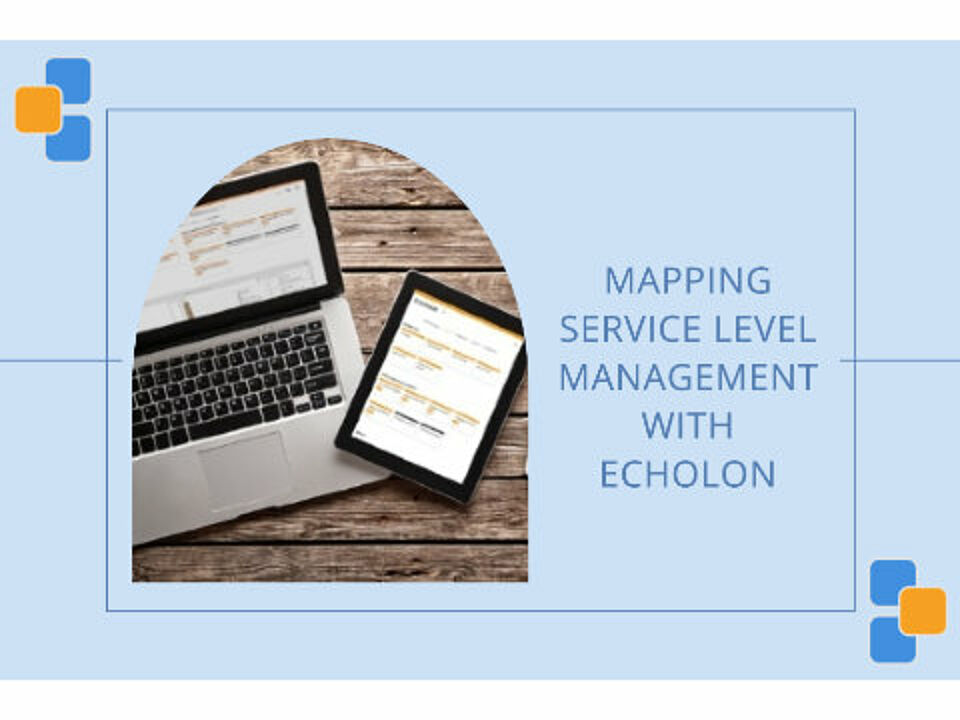Author: Ralph Bockisch
created on: 29.06.2021, last change: 17.10.2023
What does Service Level Management (SLM) cover and what are its advantages?
The demands and expectations on IT are constantly increasing. For service providers, this means that they have to define their own service portfolio precisely and communicate it with the customer. Service level management aims to increase customer satisfaction through consistent service orientation. This is achieved, for example, through Service Level Agreements (SLA), which are agreed with external customers, as well as through Underpinning Contracts (UC) with external service providers. Operation Level Agreements (OLA), which are agreed with internal service providers, are also part of service level management. Service level reporting is also one of the core tasks in SLM. In this article you will learn how IT service providers can benefit from this and how SLM can be implemented in the company.
Definition: What is Service Level Management (SLM)?
Service Level Management is used to define, optimise and monitor IT services. It is an ITIL process discipline whose main goal is to bring the performance of IT services permanently in line with customer expectations. This is to ensure a constantly high level of customer satisfaction. In this context, a distinction is made between internal customers, external customers and service providers, whose services are each defined with their own contracts or agreements.
The essential tasks in service level management include:
- Determining the business requirements of the service recipients (internal and external customers).
- Definition, control and continuous optimisation of IT services
- Creation of quality plans (target specifications) for IT services
- Defining and managing the IT service catalogue
- Development and management of supporting agreements, both with internal service providers (in the form of OLAs) and with external suppliers and service providers (as UCs)
- Regular and continuous control, monitoring and analysis of the SLAs in terms of target achievement, costs and other essential parameters
- Definition, preparation and distribution of reports on compliance with the agreed service levels
- evaluation, adaptation and optimisation of existing service level agreements
Even though service level management is the responsibility of the IT service provider, the cooperation of the customer is indispensable, especially at the beginning. The customer must describe the business processes from his perspective as precisely as possible and clearly state which IT services (hardware and software, services, personnel, etc.) are specifically required. The customer must also create the necessary conditions for implementing and using IT services (e.g. through company agreements, training, internal coordination, etc.). Once SLM has been introduced, there should be regular meetings (at least in the start-up phase) for coordination. Likewise, the client must inform the IT service provider in good time of any relevant changes in his company that affect the implementation of IT services.

What are the advantages of SLM?
Service Level Management offers six key benefits, which we present to you in more detail here:
1. customer satisfaction
The development and definition of Service Level Agreements ensures that the customer accurately states their requirements and expectations in relation to IT services. This provides important transparency and makes it possible to measure services and costs precisely and evaluate them objectively. If the agreed goals are demonstrably achieved, this increases customer satisfaction - and if not, targeted measures can be introduced to remedy any shortcomings.
2. expectation management
The expectations and requirements of the customer and the IT service can be precisely documented through SLAs. This creates clarity and security. It also ensures that new requirements are reviewed in a controlled process and renegotiated if necessary.
3. monitoring and controlling IT resources
Through active management and the installation of regular reporting, IT resources can be controlled and regulated more easily and precisely. Additional or changed needs are recognised earlier, investments or disinvestments can be made based on demand.
4. marketing support
Consistently high IT service quality is a strong marketing argument that can be used both for the acquisition of new customers and for negotiations with existing customers. The objective presentation of services (e.g. response times, system availability) makes discussions about IT services and costs more objective.
5. Cost certainty
By agreeing on SLAs, current and future needs can be determined much more precisely, thus limiting costs. Without a functioning SLM, neither technical nor human resources in IT can be planned accurately, leading to either under-resourcing (which is detrimental to customer satisfaction and quality) or under-utilisation (which unnecessarily increases costs).
6. risk minimisation
The clear definition of IT services in an SLA and the concrete task packages derived from it for the IT resources involved reduce the risk of individual tasks being forgotten or overlooked. In addition, regular reporting and the use of KPIs as early warning indicators make it possible to react quickly to irregularities and remedy them.

ITIL and SLM
ITIL - Information Technology Infrastructure Library
ITIL, short for Information Technology Infrastructure Library, is a comprehensive framework for IT Service Management (ITSM). It offers proven good practices and methods to efficiently plan, implement, monitor and improve IT services.
ITIL consists of a collection of books that cover various aspects of ITSM, including service level management. SLM is a central process in ITIL that ensures that the agreed service levels between the service provider and the customer are met.
Service Level Management in ITIL
Within the ITIL framework, SLM plays a crucial role in the delivery of high quality IT services. It defines a structured approach to agreeing, monitoring and improving service levels to ensure maximum benefit and customer satisfaction.
SLM comprises the following core processes:
- Service Level Management Process Design: This defines the roles, responsibilities and accountabilities within the SLM. It defines how service levels, SLAs, UCs and OLAs are developed and managed.
- Service level monitoring and reporting: This process involves the continuous monitoring of service levels and the production of reports on performance and compliance with agreed SLAs and OLAs.
- Service level review and improvement: At regular intervals, the agreed service levels and the processes of SLM are reviewed and, if necessary, adapted to changing requirements or business objectives.
SLM and ITIL - connections and advantages
SLM in the ITIL framework has several advantages and interrelationships:
- Integration with other ITIL processes: SLM is closely linked to other important ITIL processes such as Incident Management, Problem Management and Change Management. It ensures seamless integration and coordination between the different processes to ensure effective service operations.
- Customer focus: The SLM focuses strongly on the needs and requirements of the customer. It ensures that the IT services delivered meet the customer's expectations and business requirements. The customer perspective is at the heart of the SLM.
- Measurable service levels: By using SLAs, SLOs and SLIs in SLM, service levels can be quantified and made measurable. This enables continuous monitoring and evaluation of service quality.
- Continuous improvement: SLM promotes a culture of continuous improvement. By monitoring and evaluating service levels, weaknesses can be identified and actions taken to improve service quality.
By implementing the SLM within the framework of ITIL, service providers can establish effective service level agreements that meet customer requirements and ensure high quality service. It provides a structured approach to managing service levels and contributes to efficiency, reliability and customer satisfaction.

What is a SLA (Service Level Agreement)?
When implementing service level management, the service level agreement plays a crucial role. The SLA is a contract between a customer service provider and a customer that defines the performance obligations and expectations related to the service.
Definition and function
Service Level Management is a process in IT Service Management that ensures that the agreed service standards between a service provider and its customer are met. The goal of SLM is to design and monitor the service so that it meets the needs of the customer.
An SLA serves as the basis for the service quality agreement and defines the services provided and the associated service level objectives. It also defines the services to be provided, the scope of support, the agreed response times and the availability of the services.
Creation and implementation
The creation and implementation of an SLA takes place in close cooperation between the customer service provider and the customer. First, the customer's requirements must be recorded and documented. It is important that the agreed service agreed service levels are realistic and achievable.
During the creation of the SLA, legal aspects should also be taken into account, such as limitations of liability and confidentiality agreements. The SLA should be formulated in a clear and understandable way and should also include the processes for escalating problems and reporting on service levels.
Once the SLA has been created, it needs to be implemented and embedded in the business processes. The objectives and service levels must be made known to staff so that they can align their activities accordingly. Clear communication and training are critical to ensure that all stakeholders understand the meaning and requirements of the SLA.
Monitoring and compliance
Monitoring and compliance with the SLA is an important part of service level management. It is crucial that the agreed service levels are continuously monitored to ensure that the services meet the expected standards.
For this, Service Level Indicators (SLIs) and Key Performance Indicators (KPIs) are used to measure and monitor the performance of the services. These KPIs make it possible to identify deviations from the agreed standards at an early stage and to take appropriate action.
Compliance with the SLA can also be ensured through regular assessments and reviews. This involves checking whether the agreed goals have been achieved and whether adjustments or improvements are required.
In summary, service level management and the SLA serve to define transparent and measurable standards for services and to ensure that these standards are met. Through clear communication, monitoring and regular reviews, service providers and customers can ensure that their service level agreements are being met and that the service is meeting the customer's needs.

What are service levels?
Definition and types
A service level is a measurable property or characteristic of a service, such as response time, availability or turnaround time.
There are different types of service levels, which can vary depending on the type of service and the requirements of the customer. Common service levels include:
- Response time: The time it takes for the service provider to respond to a request or problem from the customer.
- Availability: The maximum acceptance time in which the service must be available to the customer.
- Turnaround time: The time required to complete a particular service or task.
- Performance: The performance of the service in terms of speed, capacity or throughput.
- Troubleshooting time: The time taken to resolve a fault or error.
- Customer satisfaction: The assessment of customer satisfaction with the service.
The exact service levels and their definition are set out in the service level agreement to ensure that both the service provider and the customer have a clear understanding of what services are to be provided.
Metrics and measurement
Specific metrics and measurement are used to monitor compliance with the agreed service levels. These metrics are used to assess the performance of the service and identify deviations from the agreed standards.
Examples of service level metrics are:
- Response time: The measured time from request to first response.
- Availability: The percentage of time the service was available to the customer.
- Turnaround time: The average time taken to complete a particular service.
- Error frequency: The number of errors or faults that occurred within a given period of time.
- Customer satisfaction: The assessment of customer satisfaction through surveys or feedback.
Service level metrics are usually measured using monitoring tools and systems that continuously collect and analyse data. This enables an objective and meaningful assessment of service performance.
SLA Monitoring and reporting
Monitoring and reporting of service level indicators is an essential part of service level management. Through regular monitoring, deviations from the agreed standards can be detected at an early stage. This enables the service provider to take proactive measures to improve service quality.
Monitoring includes the monitoring of relevant key figures in real time or at set intervals. By using IT systems and tools, service level managers can get an accurate overview of the service's performance.
Reporting involves the regular reporting of service level performance to all relevant stakeholders, including the customer. The reports usually contain information on the objectives achieved, deviations from the agreed standards and, where appropriate, measures for improvement.
Effective monitoring and reporting helps to improve transparency and communication between service provider and client and to ensure that agreed service levels are met.

What are agreements?
An important component of service level management are agreements that are made between the service provider and the client. These agreements ensure that the specified service levels and performance standards are met. There are different types of agreements, including contracts, underpinning contracts and operation level agreements.
Distinction between contract and agreement
A contract is a legally binding agreement between a service provider and a client that sets out the terms, rights and obligations of both parties. A contract usually regulates all aspects of the relationship between service provider and client, including agreed service levels, duration, payment terms and other relevant conditions.
An agreement, on the other hand, refers to a more informal arrangement between service provider and client. It can be verbal or written and often contains specific details about certain service levels, processes or other arrangements. Although an agreement may not be legally binding, it is still important that both parties comply with it.
UC - Underpinning Contract
An underpinning contract is a contract between the service provider and a third party to supply or support certain components or services that are required for the service provider's main service. For example, a UC may include the purchase of software licences or access to an external database. The UC sets out the agreed service levels and responsibilities for these support services.
OLA - Operation Level Agreement
An Operation Level Agreement is an agreement between different internal departments or functional units of a service provider. It defines the responsibilities, processes and service levels that apply within these departments. An OLA regulates the cooperation and coordination between the internal departments to ensure that the service is effectively delivered to the customer.
SLA vs OLA
The main difference between a Service Level Agreement and an Operation Level Agreement is the nature of the agreement and the parties involved. An SLA is an agreement between the service provider and the customer that sets out the agreed service levels and performance expectations. An OLA, on the other hand, is an agreement between internal departments of the service provider that defines the internal processes and responsibilities.
While an SLA sets out the customer's expectations for the services delivered, an OLA focuses on how the various internal departments work together to deliver those services. However, both agreements are essential components of the SLM and contribute to the effective delivery of services.
Creating and implementing agreements
Creating and implementing agreements requires careful planning and collaboration between the service provider and the client or internal departments. Here are some best practices for creating and implementing agreements:
Clear and unambiguous communication
Ensure that all parties have a common understanding of the expected deliverables, service levels and processes.
Define the content and structure
Define the content and structure of the agreement, including specific service levels, measurement processes, escalation processes and reporting.
Involve relevant stakeholders
Involve all relevant stakeholders, including internal departments or the client, to ensure that all requirements and expectations are addressed.
Ongoing monitoring and adaptation
Ensure that agreements are regularly reviewed and adapted as necessary to ensure they meet changing requirements and conditions.
Best practices
Some best practices for creating and implementing agreements include:
Clearly define service levels and objectives
Ensure that service levels are clearly defined and meet the needs and expectations of the customer.
Realistic and achievable targets
Set realistic and achievable service levels that are feasible for both the service provider and the client.
Transparent reporting and communication
Ensure clear and regular reporting on service performance and keep all relevant parties informed.
Escalation processes and conflict resolution
Define clear escalation processes for dealing with issues or conflicts that may arise to ensure quick and effective resolution.
Contractual aspects
Contractual aspects should also be considered when drafting agreements. This includes ensuring that agreements are legally valid and enforceable. It may be advisable to seek legal assistance to ensure that agreements comply with legal requirements and can be enforced in case of doubt.
In addition, contractual aspects such as limitations of liability, confidentiality agreements and other legal clauses should be included in the agreements to regulate the legal side of the agreements.
Careful consideration of and compliance with these aspects of contract law is crucial to ensure the rights and obligations of both parties and to avoid legal conflicts.

What are Service Level Objectives (SLOs)?
Definition and purpose of SLOs
Service Level Objectives are concrete goals or metrics that are set within a Service Level Agreement. They define the specific performance expectations of a service provider in relation to certain service levels.
The purpose of SLOs is to clearly define the desired quality of service and to ensure that both the service provider and the client have a common understanding of what is expected. SLOs serve as a benchmark for assessing service quality and form the basis for monitoring and measuring the services provided.
Creating and negotiating SLOs
Creating and negotiating SLOs requires close collaboration between the service provider and the client. Here are some steps to follow when creating and negotiating SLOs:
- Identify requirements: Gather the client's specific requirements in terms of service levels and performance expectations. Discuss what kind of service levels are important and what metrics should be used.
- Set realistic and achievable goals: Ensure that SLOs are realistic and achievable. Consider resources, costs and technical constraints to ensure that SLOs are feasible.
- Ensure measurability: Ensure that SLOs are measurable and that clear criteria and standards are set against which performance can be assessed. Define appropriate measurement methods and metrics to monitor progress and compliance with SLOs.
- Conduct negotiations: Discuss the SLOs with the client and make adjustments as necessary. Clarify any outstanding issues and ensure that both parties understand the SLOs and their implications.
- Written documentation: Record the agreed SLOs in writing in the SLA. Formulate the SLOs clearly and precisely, including definitions, measurement methods and agreed performance levels.
During the negotiation of SLOs, it is important that both the service provider and the client openly communicate their requirements and expectations. Good communication and mutual understanding will help to establish realistic and satisfactory SLOs that meet the needs of both parties.

What are Service Level Indicators (SLIs)?
Definition and function
Service Level Indicators are measurable metrics or ratios used to evaluate the performance of a service. They are used to provide objective data about the service and are an important part of service level management.
SLIs provide a link between service level objectives and actual performance measurements. They help to monitor the fulfilment of SLOs and make it possible to identify deviations from the agreed service levels at an early stage.
The function of SLIs is to provide data that can be used to assess service levels. They support service quality monitoring, identification of weaknesses and continuous improvement.
Selecting and measuring SLIs
Selecting and measuring SLIs requires careful planning and coordination with the service provider and the client. Here are some steps to consider when selecting and measuring SLIs:
- Understand requirements and priorities: Clarify what aspects of the service are most important to the client and what metrics should be used to measure these aspects. For example, response time, availability or turnaround time.
- Availability of data and measurement capabilities: Ensure that the necessary data to measure SLIs is available and that appropriate measurement methods exist to capture the desired metrics. It may be necessary to set up internal systems or monitoring tools to collect data continuously.
- Clearly defined measurement criteria: Establish clear criteria and standards that will be used to measure SLIs. Define how the data will be collected, evaluated and interpreted.
- Regular measurements and monitoring: Carry out regular measurements of SLIs and continuously monitor the performance of the service. Use monitoring tools or systems to collect and analyse the data.
- Compare with SLOs: Regularly compare the measured SLIs with the agreed SLOs to determine whether the service levels are being achieved. Identify deviations, analyse their causes and take action to improve if necessary.
SLIs in conjunction with SLOs
SLIs play an important role in the implementation of SLOs. They serve as objective benchmarks to check whether the agreed performance targets are being met.
SLIs make it possible to quantify the performance of a service and draw conclusions about the fulfilment of SLOs based on the data measured. For example, if the SLO specifies a response time of 30 minutes, a corresponding SLI can be measured to determine whether this requirement is being met.
Measuring and evaluating SLIs in relation to SLOs enables service providers and clients to monitor service quality, identify bottlenecks and make adjustments as needed to meet or exceed service levels. Continuous measurement and monitoring of SLIs in relation to SLOs is therefore of great importance for effective SLM.

Frequently Asked Questions about Service Level Management
FAQ - SLM
What is Service Level Management (SLM)?
Service Level Management (SLM) is a process in IT Service Management (ITSM) that deals with the agreement, monitoring and reporting of Service Level Agreements (SLAs) between the IT service provider and the internal customer.
What is a Service Level Agreement (SLA)?
A Service Level Agreement (SLA) is an agreement between the IT service provider and the internal customer that sets out agreed service level targets, performance measures, responsibilities and other specified parameters.
What are the benefits of service level management?
Service level management enables the IT service provider to meet service quality standards, improve customer satisfaction, establish clear responsibilities and make service level objectives measurable.
What is the role of service level management in IT service management (ITSM)?
Service Level Management is an important process in IT Service Management (ITSM) as it is the basis for agreeing, monitoring and reporting Service Level Agreements (SLAs).
What are KPIs in Service Level Management?
KPIs (Key Performance Indicators) in Service Level Management are measurable metrics used to evaluate the performance and efficiency of the IT service provider in delivering IT services.
Which checklists can be used in service level management?
Checklists can be used in service level management to ensure that all necessary steps and measures to improve service quality are considered.
What are the responsibilities of the IT service provider in service level management?
The IT service provider is responsible for meeting the service level targets according to the agreed SLAs, monitoring service quality, measuring KPIs and performing service reporting.
What is ITIL in the context of Service Level Management?
ITIL (IT Infrastructure Library®) is a framework for IT service management that recommends best practices and processes. Service Level Management is also a component of ITIL.
How is Service Level Management implemented?
Service Level Management is implemented by setting service level targets, defining SLAs, creating KPIs, setting up monitoring systems and regular service reporting.
What is the framework of the agreed Service Level Agreements (SLAs)?
The framework of the agreed SLAs includes the specified service level objectives, performance measurements, responsibilities, timeframes, escalation processes and other relevant parameters.

How can service level management be mapped with EcholoN?
SLM is a core component of EcholoN and is therefore available in all editions. It is based on contract management, on which the so-called service level agreements are then based. The individual agreements can then be defined via service catalogues with the specific services.
The basis is the EcholoN Ticket System with knowledge database and the Configuration Management Database (CMDB). Both are already included in the EcholoN Express Edition. In the CMDB, all devices, systems and installations (with their parts master and spare parts) can be managed. All components are mapped with dependencies so that even complex IT services can be displayed with maximum transparency.
In the ticket system, all relevant information about a customer is available to the employee in the help desk or service desk. This includes, for example, open or closed tickets, contract management (SLA) or products. Customer enquiries can be recorded centrally, answered, forwarded to the specialist department or to a specific contact person. During ticket entry, all necessary parameters (e.g. priorities, schedule, SLA, etc.) as well as keywords can be recorded and later evaluated at any time.
For less complex requirements, a self-service portal with selfhelp can be set up for customers with EcholoN. There it is possible, for example, to store FAQs that the customer can view himself. This relieves the support staff of time.
Since all enquiries and messages are booked centrally in the ticket system, the services provided can be billed reliably and at the push of a button. This also includes the mapping, administration and implementation of the service level agreements agreed with the customer, which are directly linked to the contact in the ticket system, as well as open and completed tickets and products. All billing-relevant information on resources used (time, personnel, material) is fully available in EcholoN, which simplifies, accelerates and makes billing more secure.
Field service management, i.e. the field staff on site at the customer, is also optimally supported by SLM with EcholoN, both for commissioning and maintenance as well as for repairs: travel and order times as well as material consumption are booked directly when the service is provided and summarised transparently in a digital service report. This is possible both on- and offline, thanks to the EcholoN app (for iOS, Android). The subsequent, time-consuming and error-prone recording or transfer of paper into the system is thus completely eliminated - the full service report is already available in the system when the field service is still on its way back. Important information can be automatically transferred to the connected internal knowledge database so that it can be accessed during later assignments.
Maybe also interesting:
- HowTo: Priority, impact and urgency (for registered customers)
- Blog article: What is SLA monitoring for business services?
